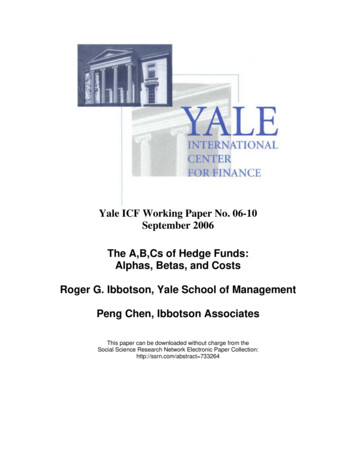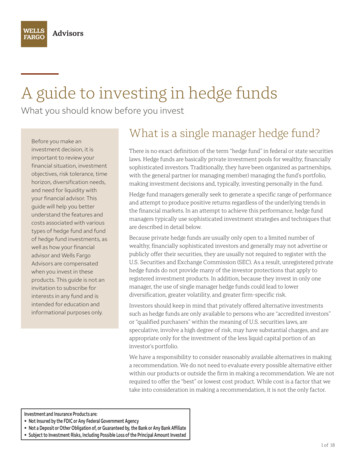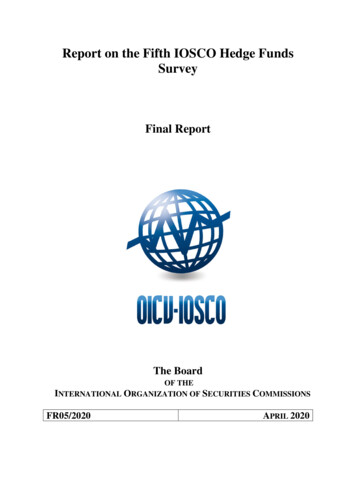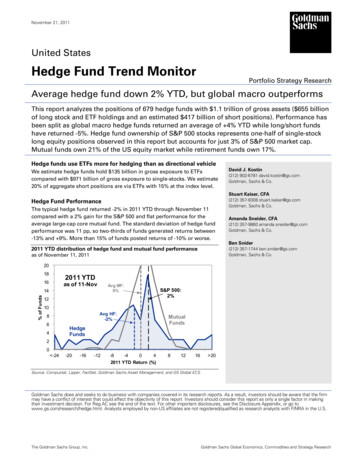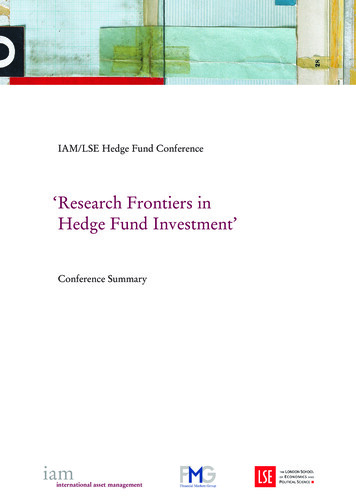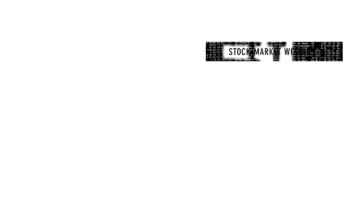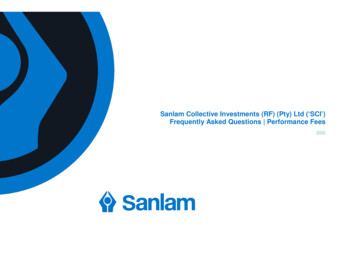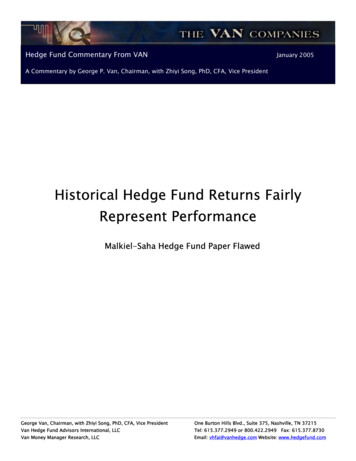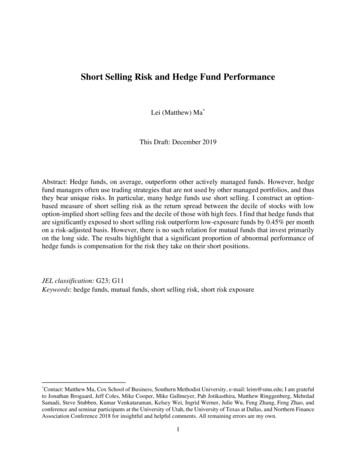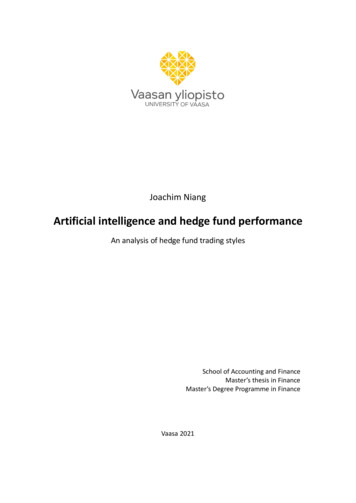
Transcription
Joachim NiangArtificial intelligence and hedge fund performanceAn analysis of hedge fund trading stylesSchool of Accounting and FinanceMaster’s thesis in FinanceMaster’s Degree Programme in FinanceVaasa 2021
2UNIVERSITY OF VAASASchool of Accounting and FinanceAuthor:Joachim NiangTitle of the thesis:Artificial intelligence and hedge fund performance : An analysis ofhedge fund trading stylesDegree:Master of Science in Economics and Business AdministrationProgramme:Master’s Degree Programme in FinanceSupervisor:Klaus GrobysYear of completing the 2021No. of pages: 132thesis:ABSTRACT:This study focuses on understanding the relationship between the level of automation employedby hedge funds on the level of performance that these funds are able to obtain. As technologiesare constantly evolving and being used to further different fields, one could ask if the adaptationof the latest technological advancements in term of artificial intelligence could be used to further the trading performance of hedge funds. As hedge funds enjoy less restrictions for theirtrading processes, they are at a prime position to take advantage of every edge that can beobtained.Using data from the Preqin hedge fund database we can to uncover this level of automation bysorting funds based on their trading styles. The term AIML hedge funds refers to hedge fundsusing both artificial intelligence and machine learning. These AIML funds are taken as their owntrading style and their performance is compared against systematic, discretionary and combinedfunds which utilize both the systematic and the discretionary methodologies in their tradingprocesses. Using both the efficient market hypothesis and the behavioral finance frameworks,we are able to conduct a detailed analysis of both the motivation for the need of automationand for the existence of hedge funds. Past literature relating to hedge fund performance, artificial intelligence and algorithmic trading, and hedge fund comparisons are also reviewed in detail. By only focusing on funds that trade U.S equities we are able to utilize common factor models used for pricing U.S. equities. Performance is analyzed both in terms of the full sample periodand by employing subsample analysis to uncover underlying performance persistence.Based on the results of our factor models we are able to see the statistically significant overperformance shown by AIML funds. Moreover, our subsample analysis supports these findings andshows that the performance obtained by AIML funds is persistent. When the effects of serialcorrelation between the fund types is taken into account the outperformance of AIML is furtherestablished. Lastly, when comparing the alphas of AIML funds against the other hedge fund trading style portfolios, AIML funds exhibit statistically significant outperformance even at a onepercent level of significance. Thus, our results indicate that by using artificial intelligence hedgefunds can improve their performance on a persistent basis and to stand out from their peers.Our results are not in breach of the efficient market hypothesis as the underlying reasons forAIML fund performance can be noted as their ability to adapt and their ability to take advantageof small market dislocations. Behavioral finance also shows how adaptability combined with anemotionless ability to execute strategies are key for AIML outperformance Our findings presentinteresting directions for future research and showcase the likely future trend of increased AIusage within the hedge fund industry.KEYWORDS: Hedge fund, Artificial intelligence, AIML, Systematic, Discretionary
3VAASAN YLIOPISTOLaskentatoimen ja rahoituksen akateeminen yksikköTekijä:Joachim NiangTutkielman nimi:Artificial intelligence and hedge fund performance : An analysis ofhedge fund trading stylesTutkinto:Kauppatieteiden maisteriOppiaine:RahoitusTyön ohjaaja:Klaus ELMÄ:Tämä tutkimus keskittyy ymmärtämään suhdetta hedgerahastojen käyttämän automatisaationja niiden saavuttaman suorituskyvyn välillä. Koska tekniikoita kehitetään jatkuvasti ja niitä käytetään eri aloilla, voidaan teorisoida, josko uusimpien teknisten kehitysten ottaminen osaksihedgerahastojen strategioita johtaa tulosten paranemiseen. Koska hedgerahastoilla on vähemmän rajoituksia kaupankäyntiin käytettäville strategioille, ne ovat ensisijaisessa asemassa hyödyntämään kaikkia saatavia etuja.Preqin-hedgerahastotietokannan avulla pystymme löytämään vastauksen tähän tutkimuskysymykseen, lajittelemalla rahastot niiden kaupankäyntityylien perusteella. Termillä AIML-hedgerahastot viitataan hedgerahastoihin, jotka hyödyntävät sekä tekoälyä että koneoppimista. NämäAIML-hedgerahastot otetaan omaksi kaupankäyntityylikseen ja niiden tuottoa verrataan systemaattisiin, harkinnanvaraisiin ja yhdistettyihin hedgerahastoihin, jotka käyttävät kaupankäynnissä sekä systemaattista että harkinnanvaraista menetelmää. Käyttämällä sekä tehokkaidenmarkkinoiden hypoteesia että käyttäytymistaloustiedettä teoreettisina viitekehyksinä, voimmesuorittaa yksityiskohtaisen analyysin sekä automatisaation tarpeen, että hedgerahastojen olemassaolon perusteista. Hedgerahastojen suorituskykyyn, tekoälyyn ja algoritmeihin sekä hedgerahastojen keskinäiseen vertailuun liittyvää aiempaa kirjallisuutta tarkastellaan myös yksityiskohtaisesti. Keskittymällä vain Yhdysvaltojen osakkeilla kauppaa käyviin hedgerahastoihinvoimme hyödyntää Yhdysvaltojen osakkeiden hinnoittelussa käytettyjä yleisten riskifaktoreidenmalleja. Suorituskykyä analysoidaan sekä koko otosjakson perusteella että käyttämällä osaotosanalyysiä paljastamaan taustalla olevan suorituskyvyn jatkuvuus.Riskifaktorimallien tulosten perusteella voimme nähdä AIML-rahastojen osoittaman tilastollisesti merkitsevän ylituoton. Lisäksi osaotos-analyysimme tukee näitä havaintoja ja osoittaa, ettäAIML-rahastojen näyttämä suorituskyky on jatkuvaa. Kun kaupankäyntityylien välisen sarjakorrelaation vaikutukset otetaan huomioon, AIML-rahastojen ylivertaisuus todetaan edelleen. Lopuksi, verrattaessa AIML-rahastojen alfa-arvoja muiden hedgerahastojen kaupankäyntityylienarvoihin, AIML-rahastot saavat tilastollisesti merkitsevän ylivertaisen tuloksen jopa prosentinmerkitsevyystasolla. Tuloksemme osoittavat, että tekoälyn avulla hedgerahastot pystyvät parantamaan suorituskykyään jatkuvasti ja erottumaan muiden kaupankäyntityylien joukosta. Tuloksemme eivät ole ristiriidassa tehokkaiden markkinoiden hypoteesin kanssa, sillä AIML-rahastojen ylituoton taustalla olevina syinä voidaan mainita niiden kyky sopeutua ja kyky hyödyntääpieniä markkinahäiriöitä. Käyttäytymistaloustiede osoittaa myös, kuinka sopeutumiskyky yhdistettynä automatisoituun kykyyn toteuttaa strategioita ovat avainasemassa AIML- rahastojen tulosten saavuttamisessa. Tuloksemme esittävät mielenkiintoisia suuntaviivoja tulevia tutkimuksiavarten ja näyttävät tekoälyn todennäköisen enenevissä määrin kasvavan merkityksen hedgerahastojen keskuudessa.AVAINSANAT: Hedge fund, Artificial intelligence, AIML, Systematic, Discretionary
4Contents12Introduction1.1Purpose of the study101.2Research hypothesis111.3Contribution121.4Structure of the thesis13Theoretical background2.145Efficient-market hypothesis15162.1.1 Active investing212.1.2 Passive investing242.238Behavioral finance262.2.1 Discretionary trading312.2.2 Systematic trading33Literature review353.1Hedge fund performance363.2Algorithmic trading and AI423.3Discretionary versus systematic approach50Hedge fund characteristics554.1Main characteristics564.2Discretionary funds644.3Systematic funds674.4Combined funds704.5AIML funds71Data and methodology755.1Data description775.2Methodology865.2.1 Capital asset pricing model875.2.2 Fama-French three-factor model895.2.3 Carhart four-factor model90
5675.2.4 Fama-French five-factor model915.2.5 Summary92Empirical results946.1Hedge fund performance6.2Hedge fund performance persistence1066.3Multiple equation models1106.4Summary of the 32Appendix 1. List of funds132
6FiguresFigure 1. Hedge Fund Management Fee Distribution and Mean Management Fee by Yearof Inception (Preqin 2021, p. 30).59Figure 2. Distribution of Hedge Fund Managers and Industry AUM by Manager Location(Preqin 2021, p. 26).59Figure 3. Proportion of Number and AUM of Hedge Funds by Top-Level Strategy (Preqin2021, p. 27).61Figure 4. Fund Manager Expectations for Hedge Fund Industry AUM in 2021 (Preqin 2021,p. 124).62Figure 5. Fund Manager Expectations for the Performance of the Preqin All-StrategiesHedge Fund Benchmark in 2021 (Preqin 2021, p. 123).63Figure 6. Number of funds per portfolio through the sample period.82Figure 7. AUM per portfolio through the sample period.83Figure 8. Annualized excess returns per portfolio through the sample period.84Figure 9. Annualized Sharpe-ratios per portfolio through the sample period.85Figure 10. Cumulative excess returns per portfolio through the sample period.86Figure 11. Time-varying MKT-factor.100Figure 12. Time-varying SMB-factor.101Figure 13. Time-varying HML-factor.102Figure 14. Time-varying RMW-factor.103Figure 15. Time-varying CMA-factor.104Figure 16. Time-varying UMD-factor.105TablesTable 1. Number of funds per trading style and most common equity strategies.79Table 2. Descriptive statistics of individual funds in sample per trading style.80Table 3. Descriptive statistics of trading style portfolios.81Table 4. Performance measurement CAPM.96Table 5. Performance measurement Fama and French three-factor model.97
7Table 6. Performance measurement with Carhart four-factor model.98Table 7. Performance measurement with Fama and French five-factor model.99Table 8. Performance persistence CAPM.107Table 9. Performance persistence Fama and French three-factor model.108Table 10. Performance persistence Carhart four-factor model.108Table 11. Performance persistence Fama and French five-factor model.109Table 12. Correlation between different trading style portfolios.110Table 13. Seemingly unrelated regression.111Table 14. Wald coefficient TMLSECArtificial intelligenceArtificial intelligence machine learningAssets under managementBehavioral financeCapital asset pricing modelCommodity trading advisorEfficient market hypothesisExchange-traded fundFinancial supervisory authorityHigh-frequency tradingMachine learningSecurities and Exchange Commission
81 IntroductionHedge funds are often characterized by the different strategies they employ. Agarwal etal. (2018) for one note that with the reduced regulation that they face, they are oftenboth more willing and capable to pursue alternative methods of investing and utilizestrategies that are not available to most other major market participants. At the sametime, continuous technological advances have created a lot of new possibilities when itcomes to the implementation and creation of different trading strategies. Kooli and Stetsyuk (2020) detail the extremely competitive environment that hedge funds operate inand the growing pressure that this creates towards hedge fund fee structures in relationto recent performance. Thus, there is a clear incentive in exploring the viability of thelatest technologies.According to the Investment Company Fact Book (2021), the total net assets for passiveexchange-traded funds (ETFs) have grown by a multiplier of four in just the U.S. in thepast decade, surpassing 4 trillion dollars. Grégoire (2020) outlines that passive management represented 42% of all US equity mutual funds in the year 2016 and noted a similarcompounding growth. As the importance of passive investing is continuing to grow andreceive more capital inflows, this results in there also being capital outflows from someother types of investment vehicles.The Preqin (2020, p. 12) report details this effect as record capital outflows as of late areseen for the wider hedge fund industry in 2019. Kooli and Stetsyuk (2020) show thatthere has been a full percentage point reduction in the capital managed by the industryin 2018, which in term makes it more apparent that the performance-to-fee relationshipof many funds is not adequate for many of their investors.Kooli and Stetsyuk (2020) uncover this relationship between fees and performance further by trying to uncover the real value added by hedge fund managers. In short, theynote the same worrying trend where hedge funds do actually perform better than theirpassive counterparts, but the same cannot be said after taking into account the notably
9higher fees. Inversely, the Investment Company Fact Book (2021) data shows the clearlydeclining expense ratios of both index mutual funds and their ETF counterparts, notingthat while increased competition plays a role for these continuously reduced fees, alsothe inherent nature of passive management is essential to take into account. As there isno need for costly active management and active analysis of the traded instruments, theexpenses are also significantly reduced.Hence, we see that the hedge fund industry is currently facing some very meaningfulchallenges. The competition is increasing, and it is also coming from players from outsidethe industry, mostly represented by passive management. Preqin (2020, p. 24-25) showsthat this results in pressure to reduce fees especially during times where the performance figures are lackluster. As the complex active analysis of securities along with thedevelopment of related trading strategies represents both the differentiating factor forhedge funds compared to other fund types and the reasoning for the added fees, it begsthe question whether this process of being active can benefit from the various technological advances that have been introduced, from trading algorithms all the way to artificial intelligence (AI).The usage of computerized trading is nothing new as it dates back to the early 1970s andthe creation of different types direct market access programs that enable the connectionbetween an algorithm and a stock exchange. Kim (2010, p. 1-4) details that these automated trading systems have then gotten more complex over time, taking on an everbigger role in the trading process. Gerlein et al. (2016) show that AI on the other handcan be understood as an evolutionary step from simple automations to tasks where theresponsibilities of the algorithm come close to, or even replace, the end-user.Harvey et al. (2017) additionally note that while algorithms are already commonplacefor many of the worlds hedge funds, their roles differ to a great extent. In their researchpaper hedge funds are divided into discretionary hedge funds which make the tradingdecisions manually and to systematic hedge funds in which the trading decisions are
10made almost or fully by using trading algorithms. Even with this clear split, the authorsnote that as technology advances, it may become ever harder to distinguish betweenthe two. The technology is here to stay, but its advantages remain to be seen.1.1 Purpose of the studyThe purpose of the study is to research whether using the latest advances in terms of AIleads to meaningful advantages when it comes to the performance of hedge funds. Inaddition to the performance figures, some descriptive statistics on these funds will alsobe uncovered as they will reveal important information relating to these funds. Onecould for example hypothesize that using AI will not only lead to levels of increased returns, but also to possible reductions in costs. On the contrary one could also theorizethat by using AI these hedge funds are able to provide higher returns that better justifythese high costs. As such the general analysis of the data is also of importance.Capocci and Hübner (2004) detail that there are almost 6000 funds managing around 400 billion in capital and as such hedge funds justify an increased attention in financialpress as well as in the academic world. The Preqin (2021, p. 5) Global Hedge Fund Reportallows us to glimpse the most current figures for the industry and the global assets undermanagement (AUM) now stand at around 3,87 trillion dollars. Additionally, the reportnotes that there are 18 303 active hedge fund managers, meaning that the number ofindividual hedge funds is even greater. Also, of interest is the forecasted growth thatthese AUM figures are expected to reach. With a forecasted compounded annual growthrate of 3,6%, the total AUM is predicted to go as high as 4,28 trillion dollars by 2025. Thatis why if anything, the importance of researching hedge funds is even more justified thanbefore.The main purpose of this thesis can therefore be simplified as an analysis on the effectof the degree of automation on the degree of performance. In other words, whetherhaving less direct interaction with the trading decisions and handing more control into
11the hands of differently advanced trading algorithms would yield better returns. Thiscontrol would then revolve from automated and predictive analysis to fully automateddecision making, where to role of the human manager would shift more into that of anobserver, with continuously lesser involvement in the day-to-day trading decisions.Therefore, this thesis aims to uncover whether advances in computing, spanning fromsimple trading algorithms all the way to extremely complex and completely self-sufficient systems are truly applicable when it comes to the quest of hedge funds aiming tooutperform. The topic is especially current as AI is starting to impact a lot of differentfields, from medicine to self-driving cars, and one could then make inferences that similar developments are bound to take place in the financial markets as well.1.2 Research hypothesisThe research question for this thesis is whether the usage of AI is able to improve hedgefund performance. For this purpose, the following hypothesis pair will be used:𝐻0 : 𝐴𝐼𝑀𝐿 ℎ𝑒𝑑𝑔𝑒 𝑓𝑢𝑛𝑑𝑠 𝑑𝑜 𝑛𝑜𝑡 𝑜𝑢𝑡𝑝𝑒𝑟𝑓𝑜𝑟𝑚 𝑓𝑢𝑛𝑑𝑠 𝑜𝑓 𝑐𝑜𝑛𝑣𝑒𝑛𝑡𝑖𝑜𝑛𝑎𝑙 𝑡𝑟𝑎𝑑𝑖𝑛𝑔 𝑠𝑡𝑦𝑙𝑒𝑠𝐻1 : 𝐴𝐼𝑀𝐿 ℎ𝑒𝑑𝑔𝑒 𝑓𝑢𝑛𝑑𝑠 𝑜𝑢𝑡𝑝𝑒𝑟𝑓𝑜𝑟𝑚 𝑓𝑢𝑛𝑑𝑠 𝑜𝑓 𝑐𝑜𝑛𝑣𝑒𝑛𝑡𝑖𝑜𝑛𝑎𝑙 𝑡𝑟𝑎𝑑𝑖𝑛𝑔 𝑠𝑡𝑦𝑙𝑒𝑠The funds of conventional trading styles are defined as funds that do not use AI, even ifstandard trading algorithms are in place. The outperformance is then measured by comparing the possible alphas obtained by these AI hedge funds against the alphas exhibitedby their conventional counterparts. In addition to this, the performance in terms of excess returns by using factor models is evaluated and the persistence of this performanceis also uncovered to make a strong case for both the outperformance against conventional style funds along with the persistence of said performance.
121.3 ContributionThis thesis aims to contribute to the growing literature on hedge funds and hedge fundperformance in various ways. Firstly, it helps to understand a lot of general informationon hedge funds and brings forth various up-to-date figures on the field. This in itself isalready valuable as is noted by Capocci and Hübner (2004) as they detail the generaldifficulty in obtaining data on individual funds. They note both the prevailing secrecywithin the field along with the fact that hedge funds are not legally required to revealalmost anything in regard to their trading, allowing them to operate out of the eye ofthe general public.Fung and Hsieh (1999) detail this further by noting the sophisticated investors that hedgefunds are only allowed to attract, meaning that regulators and financial supervisory authorities (FSAs) do not impose strict restrictions for the types of investments that thesefunds are able to pursue, or the types of disclosures that they are mandated to give.Treleaven et al. (2013) add to the theme but from the viewpoint of using trading algorithms of varying sophistication, noting the difficulty in finding the details on their usage.Therefore, being able to bring to light a very comprehensive and current dataset onhedge funds which shows factors such as AI usage and additional specifics such as theaverage size of costs for investing in such funds can be thought as being a strong contribution for the research within the field. As for any research on hedge funds, data is themost valuable and precious asset.The main contribution of this thesis will still naturally be on uncovering whether AI usagecan improve the performance of hedge funds and help them obtain performance thatsets them apart from their conventional peers. Certain publicized research papers havealready researched the performance differences between systematic and discretionaryfunds and Harvey et al. (2017) for one come to the conclusion that combining both approaches is the best course of action. Our research paper categorizes funds into systematic, discretionary and combined funds which use both the before mentioned
13approaches which enables us to revisit the findings found in their study. The main contribution being of course the addition of a fourth category, AI funds which combine elements from all the other categories but using an advanced technological framework thatsets them apart from the rest.Therefore, research into hedge fund performance will be especially furthered as to thebest of my knowledge no publicized studies carrying similar performance comparisonsfor hedge funds are available. The aim will be to give both a detailed outlook into theindustry and a detailed analysis on the performance that can be obtained with the latesttools available to these funds.1.4 Structure of the thesisThe structure of the thesis will be the following. Firstly, relevant theoretical frameworksfor the topic at hand will be researched, with both the efficient market hypothesis (EMH)and the behavioral finance (BF) being the theories that best cater to our needs. This canbe justified in short as the EMH allows us to distinguish the reasoning for the need foractive trading hedge funds in the first place if the markets are fully efficient and BF helpsus to understand some of the underlying reasons why one would want to automate theirtrading activities and remove behavioral factors from the investment process in the firstplace.Secondly, we will focus on the relevant literature within the field, starting from researchpapers focused on comparing hedge fund performance. These studies will then be analyzed and compared in a detailed manner in terms of their main findings and conclusions.The second type of research papers will be ones dedicated to algorithmic trading and AIbeing used to improve trading performance in general, as this will help give an outlookinto what the potential benefits of using such systems are and as such it will also helpdetail the motivations that hedge fund managers may generate towards employing them.Lastly, we will review literature on research papers comparing systematic and
14discretionary funds as this is the topic most related to our theme. This choice of literature review topics should help give a general overview of hedge fund performance, algorithm and AI performance, and the comparative performance studies done for thehedge funds so far.The third step in our structure will be to uncover as much information as possible onhedge funds themselves and to help obtain a deeper level of understanding of both theindividual funds and the industry that they operate in. Along with main characteristics,focus will naturally be on each of the categories of hedge fund trading styles that wehave already outlined so that also the non-numerical side of these funds gets uncovered.The fourth step will be the data and methodology stage of the thesis, where very recentfigures going up to January 2021 will be shown relating to our sample of funds and a lotof additional metrics such as AUM and fees will be seen for each hedge fund type. Additionally, our methodology for the performance comparison will be discussed.The fifth step is the actual empirical analysis of our data of hedge funds using variousfactor models. As was mentioned before in the hypothesis section, raw performance,performance persistence and performance comparison to peers will all be carried out toobtain robust results to either accept or reject our null hypothesis.The sixth and final step will naturally be the conclusion where our results are reflectedagainst the results based on the analysis of theory, the results found in the literaturereview and on the findings based on our general analysis of funds. Thus, the meaningfulness of our discoveries gets evaluated from a wider and more profound perspective.
152 Theoretical backgroundThere are a lot of different theoretical frameworks that can be considered for studyingboth the hedge fund industry and the implications of using AI technologies for assetmanagement. For the purpose of this thesis, the relation between AI usage and hedgefund performance will be explored through the viewpoints presented by the EMH andits somewhat competing counterpart, BF.Fung and Hsieh (1999) note that hedge funds are in general characterized by their usageof dynamic and non-passive strategies. The authors also detail that hedge funds are active participants within the markets while on the other hand they also display very littlecorrelation with the markets that they themselves operate in. Sun et al. (2012) remarkthe extreme secrecy among the entire hedge fund industry and the need for these fundsto keep trading strategies secret, along with the fees they impose upon their clients thatare very high when compared to other investment vehicles.Thus, it can be theorized that if investors are willing to pay a notable premium for havinga hedge fund actively manage a portion of their wealth, some market-beating returnsare likely to be obtained. Therefore, one could pose a question on whether being activecould lead to better returns as opposed to plain buy and hold passive investing. Barberand Odean (2000) on the other hand find an opposing view and note that increased active trading leads to lower returns. Hence, using efficient-market hypothesis as the firstmain frameworks for this thesis is more than justified.For BF aspects, the most immediate reasoning for its inclusion can be deducted from theman versus machine setting that is ultimately being reviewed in this thesis. Humans areemotional beings and are affected by a wide variety of different behavioral biases, fromoverconfidence to loss aversion. Algorithms and machines on the other hand can be typically thought of as emotionless machines that follow their specific objectives no matterwhat. Ritter (2003) especially writes that most people suffer from overconfidence in
16their abilities and Statman et al. (2006) and Barber et al. (2005) are able to link overconfidence with a very active level of trading.Again, it can be conceptualized that if we all suffer from behavioral biases that are detrimental to our performance as investors, using AI and algorithmic trading would in general lead to better returns. Here the question we pose is whether varying the degree ofhuman involvement and therefore reducing the degree to which behavioral factors caninterfere in the decision-making process is beneficial. Still it needs to be noted that algorithms and AI methodologies are still written and programmed by humans, making themat least theoretically susceptible to some low level of biases.Dawes (1979) indicates that when it comes to the process of forecasting, algorithms display a clear edge over their human counterparts. Continuing on that notion Prombergerand Baron (2006) note that humans favor the input of other humans more strongly thanthat of an algorithm. Lastly Kirilenko and Lo (2013) write that the effects of behavioralfactors displayed by humans affect the world of finance to an ever-greater extent thanbefore. Therefore, using the BF framework as the second main theoretical frameworkfor this study is more than relevant.2.1 Efficient-market hypothesisThe EMH is one of the foundational theories of finance that aims to describe how thefinancial markets operate. Fama (1970) explains market efficiency as simply a state inwhich the prices of securities fully reflect all of the information that is available for market participants. If this relation between market prices and information is constant, thenthey determine the market to display efficiency. The author also notes that there can beno transaction costs, the flow of information must be free and publicly available, and themarket participants themselves must be in agreement of the significance of this information in relation to the market prices for such an efficient market to exist.
17The EMH has its fair share of supporters and critics and one could easily argue that thenecessary conditions for such efficiency described above are far from realism. Though itneeds to be noted that even Fama (1970) states that it is enough for these conditions tobe sufficiently met for one to be able to observe market efficiency. Wolff andNeugebauer (2019) are one of the many researchers to note the controversy surrounding the EMH and in their research paper especially the predictability of stock returns isseen as proof for the lack of market efficiency. In addition, in their analysis they are ableto find some evidence of this predictability and as such cite a multitude of other studiesthat come to the same conclusion.Timmermann and Granger (2004) take a different approach when studying the EMH.They note that while there may be predictability in stock returns this is not somethingthat can be used as evidence against the EMH. They reason that EMH in its essence isonly concerned with the absence of arbitrage opportunities and these stock price predictabilities can very rarely be profitably exploited. Thus, taking a viewpoint where themarkets are actually inherently efficient as presumed inefficiencies are impossible totake advantage of.As the debate for and against market efficiency can be observed from many differentviewpoints
Past literature relating to hedge fund performance, artifi-cial intelligence and algorithmic trading, and hedge fund comparisons are also reviewed in de-tail. By only focusing on funds that trade U.S equities we are able to utilize common factor mod- . Hedge Fund Management Fee Distribution and Mean Management Fee by Year of Inception (Preqin .
